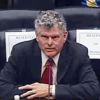Wednesday, March 27, 2013

Stopping the Keynesian Death March
In a previous Circle Bastiat post, I highlighted Rothbard’s recommendations for reducing deficits.
The two major points were:
1. “While deficits are often inflationary and always pernicious, curing them by raising taxes is equivalent to curing an illness by shooting the patient.”
2. “Deficits, then, should be eliminated, but only by cutting government spending.”
In “Escape From Spending Hell” (Wall Street Journal, March 14, 2013), Daniel Henninger discusses recent work on austerity programs by Harvard economist Alberto Alesina (with Carlo Favero and Francesco Giavazzi) that provides strong historical support for Rothbard’s points.
Henniger summarizes the current problem and possible policy options as follows:
Ever since Ronald Reagan legitimized the efficacy of tax cuts, Democrats have sought to discredit his idea and restore the New Deal theory of a Keynesian multiplier, which dates to 1931. It holds that more public spending will revive a struggling economy.
No president has believed more in the miracle of the multiplier than Barack Obama. Across four years he has led the country on a kind of Keynesian death march, pushing federal spending to 25% of GDP and producing weak growth. We’re looking at four more years before the Keynesian mast unless the Republicans can offer an intellectually respectable alternative.
 Mr. Alesina has identified the alternative. His work the past decade with how struggling economies revive suggests that the Obama spend-more solution is the opposite of what the U.S. should be doing.
Mr. Alesina has identified the alternative. His work the past decade with how struggling economies revive suggests that the Obama spend-more solution is the opposite of what the U.S. should be doing.
The work on which Mr. Henniger’s commentary is based is “The output effect of fiscal consolidations” (August 2012 for the National Bureau of Economic Research). Henniger argues that there is a general consensus on two things:
(1) The U.S. economy is emerging from the deepest recession (depression) since the Great Depression followed by, I would add, the most anemic recovery since the Depression.
(2) The public “debt level is unsustainable.”
What are the relevant results highlighted in the paper? From the abstract:
This paper studies whether fiscal corrections cause large output losses. We find that it matters crucially how the fiscal correction occurs. Adjustments based upon spending cuts are much less costly in terms of output losses than tax-based ones. Spending-based adjustments have been associated with mild and short-lived recessions, in many cases with no recession at all. Tax-based adjustments have been associated with prolonged and deep recessions. [Emphasis mine]
Last August, in The Kindest Cuts, Alesina summarized his research for City Journal. His conclusion, “Shrinking spending reduces deficits without harming the economy—unlike tax hikes.” Alesina characterizes the debate as between “deficit hawks” (supply-siders) and their opponents (Keynesians of all stripes). The “hawks” see the size of government (nearly 25% of GDP in the U.S.) and mounting debt as the major factor retarding economic growth. Thus, “There can be no sustained growth, say the deficit hawks, unless we start balancing our books.” The opponents see a sluggish economy held back by insufficient aggregate spending as the major current problem. For them, “we should eventually reign in deficits—but right now, when economies worldwide are weak, is the wrong time.” Their solution, “Governments should instead continue to run deficits and paper them over with borrowed money [or massive money creation], waiting to balance their budgets until economies get stronger.”
Alesina, correctly in my view, points out:
The deficit debate is often misleading, however, because it tends to ignore a huge difference between the two kinds of deficit reduction. The evidence speaks loud and clear: when governments reduce deficits by raising taxes, they are indeed likely to witness deep, prolonged recessions. But when governments attack deficits by cutting spending, the results are very different.
I would add that the deficit debate is misleading in another way as well. It diverts attention away from the actual problem; the size of government relative to the economy (see “A Free and Prosperous Commonwealth”). By focusing on the deficit as the problem, it makes it appear that there are two solutions to the problem, cut spending or raise taxes. Alesina’s research demonstrates why this second option, which appears as a possible solution only if the focus is on symptoms (deficits and debt) and not on the actual problem that inhibits innovation and growth: the relative size of the public sector (see Gwartney, Holcombe, and Lawson, “The Scope of Government and the Wealth of Nations).”
Alesina explains how attacking deficits by cutting spending is different, in a way which provides support for Rothbard’s two major points listed above. Why would one expect tax increases or reductions in government spending to impact the direction of the economy differently? If your only point of reference is standard Keynesianism, or any other model with a strong focus on aggregate demand, you would not. In fact, such a framework would lead one to believe that tax increases would be less harmful, as the multiplier for a given level of budget reduction is presumably smaller for the tax change than the spending change.[1] The empirical results say otherwise, according to Alesina:
The obvious economic challenge to our contention is: What keeps an economy from slumping when government spending, a major component of aggregate demand, goes down? That is, if the economy doesn’t enter recession, some other component of aggregate demand must necessarily be rising to make up for the reduced government spending—and what is it? The answer: private investment. Our research found that private-sector capital accumulation rose after the spending-cut deficit reductions, with firms investing more in productive activities—for example, buying machinery and opening new plants. After the tax-hike deficit reductions, capital accumulation dropped.
Alesina’s empirical work rediscovers and supports what supply-siders previously rediscovered, “truths long known to classical and to Austrian economics.” Expansion of government shifts resources from the productive private sector to the less productive or parasitic public sector; contraction of government does the reverse. Tax reductions will stimulate work, thrift, and productivity and tax increases retard work, thrift, and productivity. When correctly interpreted, production is demand (See Steven Kates, The Errors of Keynes's Critics). Hence the different response of an economy to spending reductions relative to tax increases as tools of austerity. Public sector austerity (spending reductions) eventually contributes to private sector prosperity. Private sector austerity (tax increases) is not a sustainable path to prosperity, public or private.
The research highlighted above suggests that those who argue that deficit reduction should be postponed until more prosperous times are wrong. Deficit reduction which focuses on Rothbard’s only approved method (reducing spending) is effective and appropriate, especially when “ideally, accompanied by other pro-growth policies”: other reductions in government interventions in the economy. Rothbard (America’s Great Depression, xix-xx) would go further:
If taxes and government spending are both slashed, then the salutary result will be to lower the parasitic burden of government taxes and spending upon the productive activities of the private sector.
Unfortunately, episodes where both taxes and spending have been cut are extremely limited. Where it did occur, the 1920s under Harding and Coolidge, and the period immediately following WWII, historical observation suggests that Rothbard is right.
Other recent research summarized in part III of “Thoughts on Capital-Based Macroeconomics” (as well as in Joe Salerno’s “Fiscal Stimulus or Fiscal Depressant?” and Garret Jones’s “Which hurts more in the short run, tax hikes or spending cuts?”) also supports Rothbard’s recommended policy. My conclusion at in that post was:
In the current economic environment—a slow recovery from a depressed economy, large government deficits and debt, and a size of the national government relative to the economy, 22-25 percent, clearly above a level consistent with adequate economic growth—Rothbard’s recommendation is a win-win policy. But as important in the long run, the Austrian policy would move the economy à la Gwartney et al. to higher sustainable growth, a path with a good chance of actually providing sufficient prosperity, to not just reduce deficits, but to pay down or ultimately eliminate the debt burden.
My earlier conclusion is reinforced by Henninger, Alesina, and Shlaes. Would there was a political will to do the right thing again. It would only be the third time in nearly 100 years. The shadow of Keynes unfortunately still darkens policy debate to the detriment of long-run prosperity.
John P. Cochran is emeritus dean of the Business School and emeritus professor of economics at Metropolitan State University of Denver and coauthor with Fred R. Glahe of The Hayek-Keynes Debate: Lessons for Current Business Cycle Research. He is also a senior scholar for the Mises Institute and serves on the editorial board of the Quarterly Journal of Austrian Economics. Send him mail. See John P. Cochran's article archives.
Notes
[1] See Stone, Core Macroeconomics, 221-240. See Salerno’s Fiscal Stimulus or Fiscal Depressant for a summary of recent empirical data casting doubt on “multipliers.”
Back To Leeconomics.com

